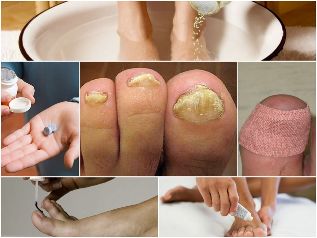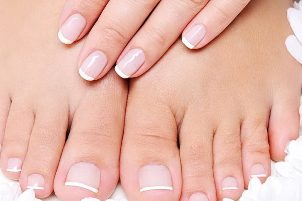To catch this disease anywhere, but there are a number of factors that contribute to the emergence and development of onychomycosis.
THE REASONS FOR THE DEVELOPMENT OF FOOT FUNGUS
-
Gender: it is proved that the fungus of the genus Candida occurs in women three times more often than men. Men are more susceptible to infection with other varieties of fungus.
-
Age: most often, nail fungus affects people over the age of thirty years. To children disease clings much less. The doctors claim that this is due to the rapid growth of the nail plate in children, and increased immunity.
-
The condition of the body: endocrine diseases, varicose veins, heart failure, blood disease, a dysbacteriosis – in the presence in the body of these diseases the risk of infection by the fungus increases. Another risk factor is the long period of taking antibiotics.
-
Trauma to the nails: even the slightest injury to the nail, for example, during the pedicure could result in the infection of onychomycosis.
-
Failure to comply with hygiene: for example, you go into saunas barefoot on the wet shower floor in a public place, using someone else's towel or put someone else's shoes. The foot fungus is a disease that is transmitted by contact – a fairly casual touch to get.
-
Job title: fungus-affected people who are forced to walk for long periods of time in tight enclosed shoes (e.g., athletes, military, miners). At risk are people whose work involves prolonged contact with water and aggressive cleaning agents, because they soften the nail plate. The fungus is also called "disease of civilization": they often suffer from people living in big cities.
-
The individual characteristics of the organism: at risk people suffering from excessive sweating of the feet. Victims of onychomycosis – people with a special anatomical shape of the foot with narrow gaps between the fingers.

THE SYMPTOMS AND SIGNS OF FOOT FUNGUS
Fungi are more susceptible to the nail plate on the toes and not the fingers. Common clinical manifestations:
-
Nail plate changed color and shape;
-
The nail is deformed, crumbly, foliated, is destroyed;
-
The stratum corneum of the skin under the nail grows;
-
The skin on the finger peels off, you feel severe itching.
Doctors identify three main stages of foot fungus: atrophic, normotrophic and hypertrophic. Each of these forms has its own symptoms. The disease can flow from one form to another, and in severe cases, the fungus looks the same.
Normotroficheskaya form: only changes the hue of the nail, its structure is preserved. Having white spots and stripes, which gradually merge and fill the entire area of the plate.
Hypertrophic form: besides the color change is observed thickening of the nail, its the fracture and stratification, the plate loses its luster.
Atrophic form: the nail is completely destroyed, the zone of growth dies off, the plate can no longer stay in the nail bed, which can lead to accidental or traumatic loss of the nail.
Fungus treatment
Affected with onychomycosis, the nails must be treated. And it is most treatable budding fungus, not running. It is very important to observe the rules of hygiene and in the prevention of disease.
Doctors believe that most effectively treated in cold seasons, namely autumn and winter. Methods of treatment depend on the degree of neglect of the case and the stage of onychomycosis.
The surgical technique used at an advanced stage. This method involves complete removal of the nail plate. But with the development of technology in the medical field, he was replaced by non-invasive laser treatment: the laser beam selectively affects diseased nail plate. The mycelium of the fungus is destroyed under the influence of his critical temperatures (the effect of thermolysis). According to studies, this method is effective in 96-100% of cases (even the running). In addition, this treatment stimulates the growth of healthy nails and does not damage the surrounding tissue. The patient after the procedure does not require recovery period, and may immediately return to normal activities. The laser method can be resorted at any stage of the disease.

At laser intervention has contraindications: pregnancy, cancer, chronic diseases in stage of decompensation, epilepsy, tendency of skin keloid scars.
Treatment medical drugs suggests courses of antifungal capsules and tablets, as well as the use of funds for the topical treatment of onychomycosis in the form of ointments, powders, gels, varnishes, etc. At the beginning of treatment, as with a laser, and by means of preparations of local action, the patient is sent to podiatry, which will make him manicure hardware. This is necessary in order to make the nail plate thinner and remove diseased tissue on or other big fingers.
Doctors do not advise to use several varnishes is not increase, but rather reduces the effectiveness of treatment of fungus. Nail every week to be washed by any conventional means for removal of varnish and cover the plate with a new layer.
To enhance the effect of treatment can be a couple times a day for several weeks to do the special baths and applications. For example, tea tree oil, ointment with propolis and vinegar solution. Shoes for prevention must be processed with special deodorant, which includes one or more components: a series, propolis, decoction of oak, celandine.
Often doctors prescribe a complex treatment of onychomycosis, i.e. the use of several methods: for example, ingestion of medicines and cover the nail plate varnish. Don't forget to treat it with ointment and lacquer adjacent to the affected nails, because fungus most likely passed on them, just have not had time to manifest.
Antifungal topical preparations must meet the following criteria:
When choosing a ointment or other medication for the treatment of fungus must pass inspection and receive consultation of the doctor-mycologist.
Prevention
It is important to understand that even after the effective treatment of fungus is always a risk to get infected again. It is therefore very important to observe personal hygiene and to engage in prevention.
-
Don't forget to take home or have a pedicure podiatry and subject to regular inspection.
-
Do not wear tight not breathable shoes made of synthetic materials. Especially if it got wet and not dried. In General, proper drying of shoes is very important in the prevention and in the treatment of fungus. The best method is the use of antifungal ultraviolet Shoe dryer. Dryer not only quickly eliminates moisture (which is a fruitful environment for fungal infections), but also acts directly on fungal organisms, inhibiting their activity.
-
Always wear your personal shoes in the pool hall, bath and other public places. Don't go there barefoot. After visiting these places, coming home, take a shower with antibacterial soap.
-
Daily wash your feet and change your socks or stockings. Use special deodorizing shoes, and skin of the feet.

You need to watch your diet. Eliminate or reduce consumption of such products: sugar, confectionery, alcohol, food refined flour. Eat more fresh and pickled vegetables (carrots, cabbage, sweet potatoes, peppers, zucchini). Drink kefir, acidophilus milk, eat cheese and cheese. The diet should be balanced and contain protein, healthy fats, carbohydrates as well as fiber and micronutrients.


























